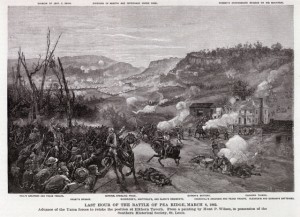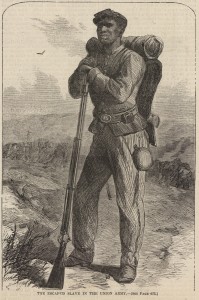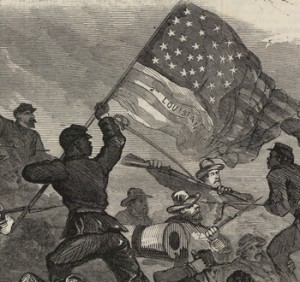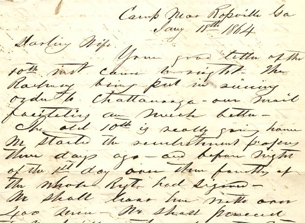 “I hope to God that I won’t have to witness the same again,” wrote Vinson Holman after his first combat experience at Pea Ridge, Arkansas. Though Holman’s regiment, the 9th Iowa, lost 216 men to casualties over the course of the three-day battle as documented by the Official Records, the Union victory on March 8, 1862 helped solidify northern control of neighboring Missouri. The Pea Ridge National Military Park preserves 4,300 acres including the entire battlefield and a newly updated visitor center and park museum, making it accessible for field trips. The National Park Service’s website provides resources for teachers that include excerpts from soldier diaries. Private Henry Dysart of the 3rd Iowa was particularly good at recording the daily life of the army soldier. On March 5, 1862, the day before the battle began, Dysart felt that it was worth noting that “Charles W. Gordon private of Co. C. 9th Missouri was drummed out of service to day in the presence of his brigade to the tune of ‘Pop goes the weasel.’” The National Park website also provides a series of visual resources that document Pea Ridge, Arkansas before, after, and during the 1862 battle through historic photographs and artwork.
“I hope to God that I won’t have to witness the same again,” wrote Vinson Holman after his first combat experience at Pea Ridge, Arkansas. Though Holman’s regiment, the 9th Iowa, lost 216 men to casualties over the course of the three-day battle as documented by the Official Records, the Union victory on March 8, 1862 helped solidify northern control of neighboring Missouri. The Pea Ridge National Military Park preserves 4,300 acres including the entire battlefield and a newly updated visitor center and park museum, making it accessible for field trips. The National Park Service’s website provides resources for teachers that include excerpts from soldier diaries. Private Henry Dysart of the 3rd Iowa was particularly good at recording the daily life of the army soldier. On March 5, 1862, the day before the battle began, Dysart felt that it was worth noting that “Charles W. Gordon private of Co. C. 9th Missouri was drummed out of service to day in the presence of his brigade to the tune of ‘Pop goes the weasel.’” The National Park website also provides a series of visual resources that document Pea Ridge, Arkansas before, after, and during the 1862 battle through historic photographs and artwork.
The Pea Ridge Military Park has also created a comprehensive website, which would be valuable for teachers exploring the many organizational elements that went into fighting the Civil War. The website includes sections that explain the use of battle flags as well as how nineteenth-century infantry, cavalry, and artillery units were organized based on their weaponry and tactics. Each section includes multiple firsthand accounts such as a William L. Fayel’s description of the temporary hospital erected in the Elkhorn Tavern: “we found the lower floors occupied with the wounded so thick that it was difficult to step between them.”
2
Jun
10
The Battle of Pea Ridge, March 6-8, 1862
Posted by solnitr Published in Civil War (1861-1865), Images, Letters & Diaries, Places to Visit Themes: Battles & Soldiers28
May
10
Fort Sumter – April 12, 1861
Posted by sailerd Published in Civil War (1861-1865), Images, Lesson Plans, Letters & Diaries, Places to Visit Themes: Battles & Soldiers After Confederates fired on Fort Sumter on April 12, 1861, President Abraham Lincoln called for 75,000 volunteers to restore order in South Carolina. This action pushed Upper South states like North Carolina and Virginia to secede and join the Confederacy. The National Park Service’s website on Fort Sumter provides a good place to start and learn more about this event. You can find historic images and modern day pictures as well as information about their education exhibit. Teachers will want to look at the curriculum material and teachers guide. In addition, the National Park Service has put together a variety of documents and essays that provide more background information on Fort Sumter. Another interesting site to check out is Tulane University’s “Crisis at Fort Sumter,” which provides a detailed timeline of what happened regarding Fort Sumter between December 1860 and April 1861. The timeline is divided into several different sections, such as “Dilemmas of Compromise” and “Final Orders.” House Divided also has some material on the Fort Sumter major topic page, including historic images and a bibliography. You will also find links to profiles of several of the individuals who were involved, such as Major Robert Anderson and Secretary of State William Henry Seward. Be sure to check out the “Documents” tab for President Abraham Lincoln’s letters to General Winfield Scott on March 9, 1861 and to Major Robert Anderson on May 1, 1861.
After Confederates fired on Fort Sumter on April 12, 1861, President Abraham Lincoln called for 75,000 volunteers to restore order in South Carolina. This action pushed Upper South states like North Carolina and Virginia to secede and join the Confederacy. The National Park Service’s website on Fort Sumter provides a good place to start and learn more about this event. You can find historic images and modern day pictures as well as information about their education exhibit. Teachers will want to look at the curriculum material and teachers guide. In addition, the National Park Service has put together a variety of documents and essays that provide more background information on Fort Sumter. Another interesting site to check out is Tulane University’s “Crisis at Fort Sumter,” which provides a detailed timeline of what happened regarding Fort Sumter between December 1860 and April 1861. The timeline is divided into several different sections, such as “Dilemmas of Compromise” and “Final Orders.” House Divided also has some material on the Fort Sumter major topic page, including historic images and a bibliography. You will also find links to profiles of several of the individuals who were involved, such as Major Robert Anderson and Secretary of State William Henry Seward. Be sure to check out the “Documents” tab for President Abraham Lincoln’s letters to General Winfield Scott on March 9, 1861 and to Major Robert Anderson on May 1, 1861.
26
May
10
Battle of Antietam
Posted by sailerd Published in Civil War (1861-1865), Images, Lesson Plans, Places to Visit Themes: Battles & Soldiers The Battle of Antietam was a key battle during the Civil War that took place on September 17, 1862. After the engagement, President Abraham Lincoln issued the preliminary announcement of the emancipation proclamation. The National Park Service website on Antietam has a number of great resources, including historic photographs by Alexander Gardner, Captain James Hope’s paintings, and a gallery of antique postcards. Teachers can find curriculum materials as well – these include lesson plans, a primary sources packet, worksheets, and scavenger hunts. Visitors can also find a nice timeline, and details on the Army of the Potomac and Army of Northern Virginia. Historyanimated.com, a non-profit educational foundation, has a great battle animation of Antietam. Antietam on the Web also provides a number of great resources, including links to all 315 of the commanders’ After-Action Reports published in the Official Records.
The Battle of Antietam was a key battle during the Civil War that took place on September 17, 1862. After the engagement, President Abraham Lincoln issued the preliminary announcement of the emancipation proclamation. The National Park Service website on Antietam has a number of great resources, including historic photographs by Alexander Gardner, Captain James Hope’s paintings, and a gallery of antique postcards. Teachers can find curriculum materials as well – these include lesson plans, a primary sources packet, worksheets, and scavenger hunts. Visitors can also find a nice timeline, and details on the Army of the Potomac and Army of Northern Virginia. Historyanimated.com, a non-profit educational foundation, has a great battle animation of Antietam. Antietam on the Web also provides a number of great resources, including links to all 315 of the commanders’ After-Action Reports published in the Official Records.
19
May
10
USCT Liberating Slaves
Posted by sailerd Published in Civil War (1861-1865), Historic Periodicals, Images Themes: Battles & Soldiers As United States Colored Troops (USCT) regiments entered southern states, they had the opportunity on numerous occasions to liberate slaves. After one USCT regiment liberated slaves from a plantation in North Carolina, an editorial published in Harpers Weekly on January 23, 1864 noted that they “[left] ‘Ole Massa’ to glory in solitude and secession.” You can read the full article here as well as view the accompanying illustration.
As United States Colored Troops (USCT) regiments entered southern states, they had the opportunity on numerous occasions to liberate slaves. After one USCT regiment liberated slaves from a plantation in North Carolina, an editorial published in Harpers Weekly on January 23, 1864 noted that they “[left] ‘Ole Massa’ to glory in solitude and secession.” You can read the full article here as well as view the accompanying illustration.
18
May
10
“The Escaped Slave and the Union Soldier”
Posted by sailerd Published in Civil War (1861-1865), Historic Periodicals, Images Themes: Battles & Soldiers, Slavery & Abolition This short editorial published in Harper’s Weekly describes two pictures of the same man – one shows him as a fugitive slave from Alabama and the other as a Union soldier. While at first he was a “poor fugitive oppressed with the weariness of two hundred long miles of dusty travel,” Harper’s Weekly explains that he enlisted in the USCT and became a “solder crowned with freedom and honor.” You can read the full editorial here.
This short editorial published in Harper’s Weekly describes two pictures of the same man – one shows him as a fugitive slave from Alabama and the other as a Union soldier. While at first he was a “poor fugitive oppressed with the weariness of two hundred long miles of dusty travel,” Harper’s Weekly explains that he enlisted in the USCT and became a “solder crowned with freedom and honor.” You can read the full editorial here.
See the images described in this editorial in the Slideshow below –
26
Apr
10
USCT Slideshow
Posted by sailerd Published in Civil War (1861-1865), Images Themes: Battles & SoldiersWatch a short slideshow or take a look at these images related to the United States Colored Troops (USCT). All of these images are from the Library of Congress Prints & Photographs Division.
12
Apr
10
Battle of Port Hudson (May 1863)
Posted by sailerd Published in Civil War (1861-1865), Historic Periodicals, Images Themes: Battles & Soldiers The Battle of Port Hudson on May 27, 1863 did not include USCT regiments organized in Pennsylvania, but it was among the first major engagements of the Civil War that involved African American regiments. The Union’s efforts in late May 1863 failed to capture Port Hudson, Louisiana, which in turn led to a siege that ended on July 9 when the Confederates surrendered. Yet even though the initial attack had failed, the African American regiments’ actions during that battle were singled out as particularly noteworthy. Union General Nathaniel P. Banks noted in his official report that “[the men’s] conduct was heroric” and that “no troops could be more determined or more daring.” In one day “they made…three charges upon the batteries of the enemy, suffering very heavy losses, and [held] their positions at nightfall with the other troops,” as Banks explained. Frank Leslie’s Illustrated Newspaper published Banks’ report along with a poem written by a Philadelphia poet. Some northerners questioned whether USCT regiments would be effective against Confederate forces, but this battle and others provided irrefutable evidence as to how wrong their original assumptions had been. “We may be sure” that those regiments, “after Port Hudson, [will not] be again exposed to sneers or insult,” as a Harper’s Weekly editorial concluded.
The Battle of Port Hudson on May 27, 1863 did not include USCT regiments organized in Pennsylvania, but it was among the first major engagements of the Civil War that involved African American regiments. The Union’s efforts in late May 1863 failed to capture Port Hudson, Louisiana, which in turn led to a siege that ended on July 9 when the Confederates surrendered. Yet even though the initial attack had failed, the African American regiments’ actions during that battle were singled out as particularly noteworthy. Union General Nathaniel P. Banks noted in his official report that “[the men’s] conduct was heroric” and that “no troops could be more determined or more daring.” In one day “they made…three charges upon the batteries of the enemy, suffering very heavy losses, and [held] their positions at nightfall with the other troops,” as Banks explained. Frank Leslie’s Illustrated Newspaper published Banks’ report along with a poem written by a Philadelphia poet. Some northerners questioned whether USCT regiments would be effective against Confederate forces, but this battle and others provided irrefutable evidence as to how wrong their original assumptions had been. “We may be sure” that those regiments, “after Port Hudson, [will not] be again exposed to sneers or insult,” as a Harper’s Weekly editorial concluded.
See images related to this event in the Slideshow below –
6
Apr
10
Abraham Lincoln in 1860 at the Library of Congress
Posted by Published in Antebellum (1840-1861), Images, Lesson Plans, Letters & Diaries Themes: Contests & Elections The Library of Congress provides a wealth of resources for teachers to use in the classroom. Most helpful are the themed Collection Connections, which seek to give historical context to the Library’s collections and assist teachers in using them in the classroom. One of these Collection Connections is on the Abraham Lincoln papers. In this section, documents by Abraham Lincoln have been selected for each of several categories. These resources are invaluable for anyone studying the life and times of Abraham Lincoln. One of the categories is Lincoln’s 1860 presidential campaign. There are four key documents included to illustrate this period of Lincoln’s life, including speech notes, campaign posters, and a letter. This selection of a few key documents serves to underscore the main themes and events of the campaign, and there are discussion questions included as well for teachers to use in the classroom. The page presents the information in a clear way but requires a critical reading of the texts as well. To help students further analyze the documents, there is a critical thinking page designed to give assistance with interpretation and analysis of events during Abraham Lincoln’s lifetime.
The Library of Congress provides a wealth of resources for teachers to use in the classroom. Most helpful are the themed Collection Connections, which seek to give historical context to the Library’s collections and assist teachers in using them in the classroom. One of these Collection Connections is on the Abraham Lincoln papers. In this section, documents by Abraham Lincoln have been selected for each of several categories. These resources are invaluable for anyone studying the life and times of Abraham Lincoln. One of the categories is Lincoln’s 1860 presidential campaign. There are four key documents included to illustrate this period of Lincoln’s life, including speech notes, campaign posters, and a letter. This selection of a few key documents serves to underscore the main themes and events of the campaign, and there are discussion questions included as well for teachers to use in the classroom. The page presents the information in a clear way but requires a critical reading of the texts as well. To help students further analyze the documents, there is a critical thinking page designed to give assistance with interpretation and analysis of events during Abraham Lincoln’s lifetime.
26
Mar
10
Captain Noah Hart Papers (1862-1865)
Posted by sailerd Published in Civil War (1861-1865), Historic Periodicals, Images, Letters & Diaries Themes: Battles & SoldiersThe Noah Heart Papers at Dominican University offer an interesting perspective on the Civil War from a Union officer. Noah, who served with the 10th Michigan Infantry, wrote a number of letters to his wife, Emily, between 1862 and 1865. His regiment took part in several campaigns, including General William T. Sherman’s March to the Sea. While outside Atlanta in August 1864, Noah described one of the problems with his regiment’s supply chain. The 10th Michigan Infantry “lines of communication..are of immense length already,” and as Noah observed, “the farther we penetrate into the enemies country the more they become exposed.” “[If [the Confederates] should cut off our Cracker and Bacon line,” Noah concluded that “we would be in a pretty fix.” This collection also includes Noah’s military records, parts of Noah’s diary, newspaper clippings related to the Hart family (such as Noah’s obituary), and several photographs.
22
Mar
10
William Elisha Stoker: A Texas Farmer’s Civil War
Posted by sailerd Published in Civil War (1861-1865), Historic Periodicals, Images, Letters & DiariesListen to the essay
Editor’s Comments:
This essay was originally prepared for an exhibit co-sponsored by the National Civil War Museum in Harrisburg and available online at http://housedivided.dickinson.edu/stoker/
Search
Administration
Recent Post
- Black Employees and Exclusive Spaces: The Dickinson Campus in the Late 19th Century
- Friend or Foe: Nineteenth Century Dickinson College Students’ Perception of Their Janitors
- Teaching Gettysburg: New Classroom Resources
- Coverage of the Gettysburg Address
- Welcome to Chicago: Choosing the Right Citation Generator
- Augmented Reality in the Classroom
- Beyond Gettysburg: Primary Sources for the Gettysburg Campaign
- African Americans Buried at Gettysburg
- The Slave Hunt: Amos Barnes and Confederate Policy
- Entering Oz – Bringing Color to History
Recent Comments
- George Georgiev in Making Something to Write Home About
- Matthew Pinsker in The Slave Hunt: Amos Barnes and Confederate Policy…
- linard johnson in Making Something to Write Home About
- Bedava in The Slave Hunt: Amos Barnes and Confederate Policy…
- Adeyinka in Discovering the Story of a Slave Catcher
- Stefan Papp Jr. in Where was William Lloyd Garrison?
- Stefan Papp Jr. in Where was William Lloyd Garrison?
- Jon White in Albert Hazlett - Trial in Carlisle, October 1859
- Pedro in Discovering the Story of a Slave Catcher
- Matthew Pinsker in Register Today for "Understanding Lincoln," a New …





















